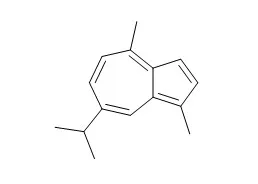| In vitro: |
| Toxicol In Vitro. 2011 Feb;25(1):64-72. | | Cytotoxic activity of guaiazulene on gingival fibroblasts and the influence of light exposure on guaiazulene-induced cell death.[Pubmed: 20854889 ] | Guaiazulene (GA) is widely used as a natural ingredient in many health care products and solutions. Although it has been reported to have interesting biological effects, GA and azulene derivatives have been proven to be cytotoxic against normal human cells and human tumor cells; moreover, Guaiazulene has shown photomutagenic properties on bacterial strains.
METHODS AND RESULTS:
Therefore, we evaluated and compared the cytotoxicity of GA at different concentrations on human gingival fibroblast (HGF) cell cultures under normal conditions and under UV irradiation (UV-A dose: 6.4 J/cm(2)). The compound tested was found to significantly reduce cell viability (dose-dependent trend, IC(50) 72.1 μM), decrease protein procollagen α1 type I synthesis, a marker for HGF protein, and COL1A1 mRNA expression. The cytotoxic effects were accompanied by activation of an intrinsic apoptotic pathway, studied using transmission electron microscopy (TEM) and caspase-3 activation.
CONCLUSIONS:
The light exposure of the cell culture treated decreased GA-induced cell death (IC(50) 128.9 μM), suggesting a photoprotective effect due to the photodegradation of the toxic agent, Guaiazulene. Furthermore, the products of the photodegradation reaction of GA proved not to be toxic against HGFs. | | Biomed Pap Med Fac Univ Palacky Olomouc Czech Repub. 2014 Jun;158(2):208-11. | | In vitro antimicrobial activities of cinnamon bark oil, anethole, carvacrol, eugenol and guaiazulene against Mycoplasma hominis clinical isolates.[Pubmed: 23128812] | The aim of this study was to evaluate the antimicrobial effects of five natural substances against 50 clinical isolates of Mycoplasma hominis.
METHODS AND RESULTS:
The in vitro activity of selected natural compounds, cinnamon bark oil, anethole, carvacrol, eugenol and Guaiazulene, was investigated against 50 M. hominis isolates cultivated from cervical swabs by the broth dilution method. All showed valuable antimicrobial activity against the tested isolates. Oil from the bark of Cinnamomum zeylanicum (MBC90 = 500 μg/mL) however was found to be the most effective. Carvacrol (MBC90 = 600 μg/mL) and eugenol (MBC90 = 1000 μg/mL) also possessed strong antimycoplasmal activity.
CONCLUSIONS:
The results indicate that cinnamon bark oil, carvacrol and eugenol have strong antimycoplasmal activity and the potential for use as antimicrobial agents in the treatment of mycoplasmal infections. |
|
| In vivo: |
| J Pharm Pharmacol. 1997 Sep;49(9):938-42. | | Antioxidant activity of guaiazulene and protection against paracetamol hepatotoxicity in rats.[Pubmed: 9306266] | The effect of Guaiazulene, a lipophilic azulene derivative widely found in nature, on radical-mediated processes is examined. The ability of guaizulene to inhibit rat hepatic microsomal membrane lipid peroxidation and to scavenge hydroxyl radicals, as well as to interact with 1,1-diphenyl-2-picrylhydrazyl radical (DPPH), was estimated.
METHODS AND RESULTS:
It was found that Guaiazulene can inhibit lipid peroxidation very significantly, having an IC50 value of 9.8 microM. It can also scavenge hydroxyl radicals and interact with DPPH. The protection afforded by Guaiazulene to rats with paracetamol-induced liver injury was also investigated. Paracetamol hepatotoxicity is caused by the reactive metabolite N-acetyl-p-benzoquinone imine (NAPQI), which causes oxidative stress and glutathione (GSH) depletion. Hepatic cytosolic protein, GSH, glutathione transferase and glutathione reductase levels are determined as indices of hepatic injury with or without the administration of Guaiazulene. It was found that all parameters affected by paracetamol are restored to normal by Guaiazulene treatment, while the administration of Guaiazulene alone has no effect on the performed tests compared with the control values.
CONCLUSIONS:
It was concluded that the significant protection against paracetamol-induced GSH depletion and hepatic damage afforded by Guaiazulene is probably connected with its antioxidant activity. A molecular mechanism of action of Guaiazulene is suggested. |
|






 Cell. 2018 Jan 11;172(1-2):249-261.e12. doi: 10.1016/j.cell.2017.12.019.IF=36.216(2019)
Cell. 2018 Jan 11;172(1-2):249-261.e12. doi: 10.1016/j.cell.2017.12.019.IF=36.216(2019) Cell Metab. 2020 Mar 3;31(3):534-548.e5. doi: 10.1016/j.cmet.2020.01.002.IF=22.415(2019)
Cell Metab. 2020 Mar 3;31(3):534-548.e5. doi: 10.1016/j.cmet.2020.01.002.IF=22.415(2019) Mol Cell. 2017 Nov 16;68(4):673-685.e6. doi: 10.1016/j.molcel.2017.10.022.IF=14.548(2019)
Mol Cell. 2017 Nov 16;68(4):673-685.e6. doi: 10.1016/j.molcel.2017.10.022.IF=14.548(2019)